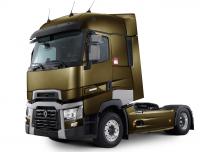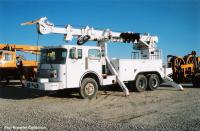Renault Trucks model T enters the market

Renault Trucks has taken advantage of the proposed new Euro 6 standard to completely renew its Long Distance range. Designed and developed in collaboration with fifty customers from around the world, the T has been subjected to the most extensive and thorough series of tests in the company’s history. The Renault Trucks T is a unique, modular vehicle from the new Long Distance range, with a spacious, highly aerodynamic cab. "With its aerodynamic cab, developed and tested with the aid of a wind tunnel, the T combines the Premium Long Distance’s efficiency and low fuel consumption with the Magnum’s comfort and prestige – in a single new vehicle", tells us the official press-release.
The new Long Distance range offers numerous unprecedented benefits. The first source of pride for drivers is the design of their truck. With its imposing “pi” shaped radiator grille and boomerang indicator light layout, the Renault Trucks T exudes relentless determination. With a basic cab that is larger than those on the Premium Long Distance, four different cab versions, and a width of 2.5 metre, the Renault Trucks T offers the perfect working and resting environment for long-distance drivers. The High Sleeper Cab version of the T has a completely flat floor, and for cabs with engine tunnels, this has been lowered to just 200mm. Great care has been taken in designing the seats, which can be adjusted to the driver’s body-shape. Designed for Renault Trucks by RECARO®, they are more user-friendly and comfortable, offering an excellent level of comfort on even the longest journey. The height, depth and angle of the steering wheel can also be adjusted.
The Renault Trucks Long Distance Range meets the needs of everyone operating in the road haulage sector - industrial transport, controlled temperature transport, tanker transport, and livestock transport. Above all, customers in the first two categories seek to reduce operating costs to a minimum and maintain efficient journey speeds, making a Sleeper (available on the DTI 13 and DTI 11) or High Sleeper the perfect choice. Tanker transport hauliers, for whom load capacity is the main concern, will opt for a Day or Night & Day cab and a DTI 11 engine. Customers transporting livestock and looking for maximum driver comfort in a prestige vehicle will choose the High Sleeper Cab version of the T, which has a flat floor and a DTI 13 engine of up to 520 hp. The T cab, exclusive to Renault Trucks, was developed to promote fuel savings. The best illustrations of this are its windscreen, set at an angle of 12°, its trapezoid form, 2.3 metre wide at the front and 2.4 metre wide at the rear, and its integrated reflector optics.
The interior of the T has been designed to provide a clear separation between the driving area and the L-shaped rest area, formed by the passenger seat, which can be swivelled round, and the lower and/or upper bunk(s), depending on the version selected. The lower bunk has a Bultex® mattress which can be extended to a width of 800mm. The upper bunk has an integrated ladder, which can be partly folded back if not needed, providing the driver with extra storage space.
As for engines, the Renault Trucks T features Euro 6 DTI 11 and DTI 13 engines. The whole range is fitted with the Optidriver automatic transmission, which now has a new gear change management system. The T also boasts a brand new air control system (Electronic Air Control Unit or EACU), a variable flow steering pump to improve consumption and Diesel tank capacity of up to 1,475 litres. Maintenance has been made easier by separating the electrical harness path from the hydraulic harness path in the vehicle body, with electrics on the right and hydraulics on the left.
Renault Trucks used its Euro 5 engine blocks as the basis for developing the new Euro 6 DTI 11 and DTI 13 engines and also decided to optimise SCR technology. The original blocks, already well-known for their efficiency and low fuel consumption, underwent major modification, involving over 50% of their design. The SCR system was revised and made more efficient. The use of new materials in its manufacture improved catalytic reduction performance and efficiently reduced the NOx emissions. It has now also been fitted with a particulate filter.


